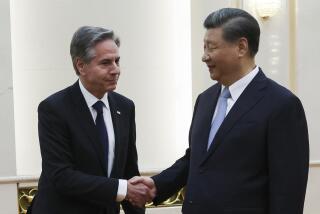China’s stimulus plan sets high bar
- Share via
SHANGHAI — Potentially providing an important lift to a faltering global economy, China unveiled plans Sunday to pump about $586 billion into infrastructure projects and other stimulus measures to bolster domestic demand and shore up its weakening economy.
The massive two-year stimulus package, which one analyst described as China’s version of America’s New Deal, represents one of the most aggressive actions to date by a country to counter the effects of the global financial crisis.
It comes as China’s president, Hu Jintao, prepares to join President Bush and other world leaders Saturday for a global economic summit in Washington. President-elect Barack Obama has called on U.S. lawmakers to take swift action to pass a stimulus package as well.
During the summit, leaders of major economies are expected to discuss a coordinated fiscal stimulus, much like lock-step actions by nations in recent weeks to inject capital into banks and to lower interest rates.
China’s move could set a bar for other countries to follow, said Carl B. Weinberg, chief economist at High Frequency Economics.
China’s plan would include tax cuts, a loosening of credit and government spending through 2010 on a wide range of programs, including construction of low-income housing, transportation systems and the development of rural infrastructure, the official New China News Agency said.
Analysts welcomed the larger-than-expected stimulus package, which amounts to a hefty one-sixth of China’s annual economic output. They said the spending would help businesses, boost demand for commodities and raise consumption.
China’s announcement appeared to give an immediate lift to investors’ confidence, as stock markets today rose in Asia and Australia. Chinese stocks jumped the most in seven weeks, gaining as much as 5.9% in morning trading.
“The Chinese stimulus package is a bold and very positive step for the Chinese and global economies,” said Mark Zandi, chief economist at Moody’s Economy.com in West Chester, Pa.
With the U.S., Japan and much of Europe staring at recession, China’s role looms ever larger because it has been a major driver of global economic growth in recent years. China’s rapid expansion has spurred trade and commodity purchases and prices. Many multinational companies are looking to China’s large market to help them ride out the turbulence of the worst global downturn in decades.
But China’s economic growth has slowed sharply this year, to an annual pace of 9% in the third quarter compared with nearly 12% for all of last year. Tens of thousands of Chinese factories have closed this year, and more are at risk as export orders from the United States and elsewhere shrink. China’s real estate market has also been sagging, damping investments and consumer spending.
Before Sunday’s announcement, some analysts had predicted that China’s economic growth would fall to as low as 6% next year -- a disturbing prospect for Chinese officials because of the threat of rising joblessness and the risk of social instability. Analysts said the stimulus package would probably lift growth next year to 8% or higher.
“This broad-based fiscal stimulus program will emerge as the government’s front line of defense against an excessive economic slowdown,” said Jing Ulrich, managing director of China equities at JPMorgan Chase in Hong Kong.
Likening the package to President Franklin D. Roosevelt’s New Deal during the Great Depression, Ulrich said higher social-welfare spending and rural reforms would stimulate private consumption.
In the U.S., Democratic leaders of Congress are looking to approve a stimulus package of about $60 billion to $100 billion. But as in other countries, officials also are concerned about increased public spending at a time when fiscal budgets are under strain.
That’s not a concern for China, with its $2 trillion in foreign reserves and a reported fiscal surplus of $175 billion in the first half of this year. The package is much larger than Beijing’s fiscal injection during the Asian financial crisis in 1997.
“China can afford massive fiscal stimulus,” Weinberg said. He added that the biggest windfall for China from this package was political as it showed the nation’s capacity to contribute to global economic stability.
China “will demand a more equal footing after this [summit] meeting,” Weinberg said, noting that China has thus far been a minor player in the power structure of organizations such as the International Monetary Fund and the World Bank.
Beijing’s stimulus package is the largest of a series of steps taken recently to spur the nation’s growth. Previous measures have included interest-rate cuts, tax rebates for exporters and reduction of reserve requirements for banks so more money could be made available for lending. China also previously has pledged substantial funds for various infrastructure and rural-development projects.
It wasn’t clear whether previously committed money was included in the new stimulus amount. The announcement Sunday indicated that China would spend about $58.6 billion in the current quarter, with additional funds to be used over the next two years to finance programs in 10 major areas, including water, electricity, technological innovation and rebuilding from disasters such as the May 12 earthquake.
Ulrich said Beijing had huge infrastructure projects planned from now to 2020.
“Despite the weakening economy and slowing tax revenue in recent months,” she said, “the government has every political incentive to boost spending in priority programs.”
--
More to Read
Inside the business of entertainment
The Wide Shot brings you news, analysis and insights on everything from streaming wars to production — and what it all means for the future.
You may occasionally receive promotional content from the Los Angeles Times.










